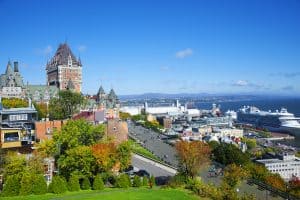 April 13, 2018 – Small Quebec towns are seeing some of the lowest unemployment rates in Canada, with businesses offering better packages and focusing on immigrants to fill in-demand positions.
April 13, 2018 – Small Quebec towns are seeing some of the lowest unemployment rates in Canada, with businesses offering better packages and focusing on immigrants to fill in-demand positions.
Chaudiere-Appalaches had a March unemployment rate of 3.4 per cent, while Abitibi-Temiscamingue saw just 4.5 per cent of people out of work, against a provincial rate of 5.6 per cent and a Canada-wide rate of 5.8 per cent.
Once associated with high unemployment, Quebec is now third behind British Columbia (4.7 per cent) and Ontario (5.5 per cent) among the best performing provinces in Canada.
Jobs Data in Canada’s Provinces
| Jobs change January March | Unemployment rate (%) | |
| 1) British Columbia | -3,900 | 4.7 |
| 2) Ontario | 10,600 | 5.5 |
| 3) Quebec | 16,000 | 5.6 |
| 4) Saskatchewan | 4,200 | 5.8 |
| 5) Manitoba | 900 | 6.2 |
| 6) Alberta | 8,300 | 6.3 |
| 7) Nova Scotia | -1,300 | 7.4 |
| 8) New Brunswick | -1,800 | 8.0 |
| 9) Prince Edward Island | -200 | 10.3 |
| 10) Newfoundland & Labrador | -400 | 14.2 |
| CANADA | 32,300 | 5.8 |
Source: Statistics Canada
Statistics Canada figures show the rate has fallen 0.7 per cent in the last 12 months, and 1.8 per cent in the last two years. In the last year, the province has added nearly 150,000 jobs, a 4.5 per cent increase that is the largest full time increase of any province.
Historically, new immigrants have found it difficult to find jobs in their field in Quebec, particularly where language barriers exist. Well-qualified newcomers have found themselves working positions not representative of their qualifications.
But now some employers are actively looking for immigrants to fill positions. A recent Montreal careers fair highlighted the shortage of qualified people, with businesses happy to focus on new immigrants provided they had the required qualifications.
Officials will be hoping the low rural unemployment will help motivate immigrants to spread out into rural Quebec, where newcomers are traditionally concentrated in Montreal.
Population Growing
Quebec’s population stood at 8.4 million in 2016, up by 68,500 over the course of the year, the Institut de la statistique du Québec recently reported.
This makes the growth rate 0.82 per cent, up from 0.6 per cent in 2015. Early analysis also suggests the growth continued to increase in 2017.
Although the current numbers are still lower than the 2009 population increase of 1.1 per cent, the increase in growth rate represents a positive trend.
The French-speaking province welcomed 53,250 immigrants in 2016, up from 49,000 in 2015, the Institut de la statistique du Québec figures also show. The 2016 numbers were spearheaded by the influx of Syrian refugees.
Read More
How Ottawa Can Halt Thousands of Quebec Immigration Investors Settling in Vancouver and Toronto
Canada Intercepts Nearly 21,000 Asylum Seekers in 2017, Mainly in Quebec (Audio)
Quebec Offers Fast Permanent Immigration Pathway to Canada for International Students
Quebec Sees Net Population Loss of 37,000 To Interprovincial Migration
Quebec to Welcome Near 53,000 Immigrants in 2018
The province still suffers from high losses to inter-provincial migration, although the statistics suggest the numbers are falling.
Quebec plans to welcome between 49,000 and 53,000 new permanent residents under all programs in 2018.
The numbers are within the same range as the 2017 Quebec immigration targets.
The figures show a slight increase in the number of economic immigrants offset by a slight decline in family reunification and refugee immigration numbers.
Quebec Immigration Categories
Quebec Skilled Worker
Quebec Business Immigration
Quebec Experience Program
Quebec Immigration Admission Targets 2018
| Category | Minimum | Maximum |
| Economic immigration | 28,700 | 31,300 |
|
24,200 | 26,300 |
|
4,000 | 4,300 |
|
500 | 700 |
| Family reunification | 11,600 | 12,100 |
| Refugees and people in similar situations | 8,100 | 8,800 |
|
5,600 | 6,000 |
|
1,550 | 1,600 |
|
4,050 | 4,400 |
|
2,500 | 2,800 |
| Other immigrants** | 600 | 800 |
| Total | 49,000 | 53,000 |
* Includes caregivers and other economic class immigrants
** Includes various special categories of immigrants admitted on humanitarian or public interest grounds
The Quebec government has exclusive jurisdiction to manage its own comprehensive immigration programs, under a series of agreements dating back to 1981. It has the largest allocations of immigrants to Canada, among the 10 provinces and 3 territories accounting for approximately 17 per cent of Canada’s planned overall annual immigration levels for 2018.
Interested employers: Kindly contact us here to receive further information.
Interested candidates: Find out whether you qualify to Canada by completing our free on-line evaluation. We will provide you with our evaluation within 1-2 business days.
Read more news about Canada Immigration by clicking here.




